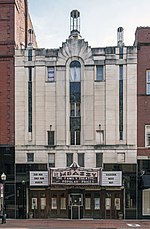Cumberland Dam
Buildings and structures in Allegany County, MarylandBuildings and structures in Cumberland, MarylandBuildings and structures in Mineral County, West VirginiaChesapeake and Ohio CanalDams completed in the 19th century ... and 3 more
Dams in MarylandDams in West VirginiaUnited States privately owned dams

The Cumberland Dam was built across the North Branch of the Potomac River at Cumberland, Maryland, for the purpose of diverting water of the river into the head of the Chesapeake and Ohio Canal. The Chesapeake and Ohio Canal Company began construction of its Dam No. 8 in 1837 and work proceeded intermittently, finally concluding in 1850.: 242 The dam impounded water over a distance of a mile, causing back water for about 3 miles (4.8 km) up the river. Above the dam is the mouth of Wills Creek.
Excerpt from the Wikipedia article Cumberland Dam (License: CC BY-SA 3.0, Authors, Images).Cumberland Dam
Martinspforte,
Geographical coordinates (GPS) Address Nearby Places Show on map
Geographical coordinates (GPS)
| Latitude | Longitude |
|---|---|
| N 39.648472222222 ° | E -78.765694444444 ° |
Address
Martinspforte 1
67547 , Worms-Zentrum (Innenstadt)
Rheinland-Pfalz, Deutschland
Open on Google Maps







